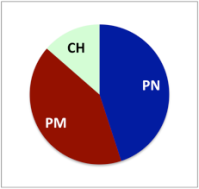 Key facts
Key facts
Located in subregion / area: Vallée de la Marne / Vallée de la Marne Ouest (formerly in the Terroir de Condé)
Vineyards and grape varieties: 48.5 hectares (119.8 acres), of which 45% Pinot Noir, 41% Pinot Meunier and 14% Chardonnay.
Classification: “Autre cru” (83%)
Maps

The map is linked from Wikimedia Commons, and the geographical information originates from OpenStreetMap. The dotted white area corresponds to the vineyards, light yellow is other open terrain, orange is built-up areas, and green indicates forest.
Google Maps view with the villages in the Vallée de la Marne Ouest highlighted, as well as some surrounding villages in white.
Clicking on a village opens a field to the left with a link to the village profile, if there is one.
Neighbouring villages
Northeast: Reuilly-Sauvigny
Southeast: Monthurel
Northnorthwest: Crézancy
Comment: some of the villages to the southwest are not included in the list above, since they are outside the appellation and therefore will not be profiled.
The town hall (mairie) and the church (Église Saint-Georges) in Connigis. Picture linked from Wikimedia Commons (photo G.Garitan, 2014).
The village
Connigis is located on the left bank of the Marne river, which means south of the river. The village is located at Le Surmelin, a river which empties into the Marne River downstreams at Mézy-Moulins.
The Connigis commune covers 546 hectares and has 324 inhabitants (as of 2015), referred to as Connigeois and Connigeoises.
The Union des Maisons de Champagne used to count Connigis as part of the area Terroir de Condé. This was not very surprising, since the area was named for Condé-en-Brie (which itself isn’t a Champagne village), which is located close to Connigis. Around 2017 the borders were adjusted for the areas close to the departmental border between the Marne and Aisne department. Currently, UMC counts Celles-lès-Condé as part of the Vallée de la Marne Ouest, the Western Marne Valley.

The church in Monthurel, Église Saint-Georges. Picture linked from Wikimedia Commons (photo Jpduburcq, 2007).
Vineyards
The vineyards in Connigis are gathered in a single block in the slope above the village, and are continuous with those in Monthurel. The vineyards are southwest- to west-facing with Pinot Meunier as the most common grape variety and Pinot Noir a close second.
The current vineyard surface in the Celles-lès-Condé commune is 48.5 hectares (119.8 acres). There are 21.8 ha Pinot Noir (44.9%), 20.1 ha Pinot Meunier (41.4%), and 6.6 ha Chardonnay (13.6%). Numbers from CIVC, as of 2013. In 1997, the vineyard surface was 51 ha. There are 11 vineyard owners (exploitants) in the commune.
Champagne producers
Champagne growers
Producer status is indicated where known: RM = récoltant-manipulant, or grower-producers. RC = récoltant-coopérateur, growers that are cooperative members but sell Champagnes under their own name.
- Cellier & Fils (RC, Facebook), formerly Simon Cellier et Fils. The range includes a vintage Champagne.
- Chevreux-Bournazel (RM, Facebook), also known as La Parcelle after their first Champagne. The started their Champagne production in the 2012 vintage using a 0.4 ha plot of Pinot Meunier in Barzy-sur-Marne. Later, a plot in Connigis was added. They use oak barrel vinification and despite the small scale they have received positive attention for their Champagnes. Other than the original La Parcelle, the range includes Le Bouc and La Capella, the latter introduced in 2018 (village of origin is Barzy-sur-Marne). They also produce a still white wine (Coteaux Champenois) and Ratafia.
- Pierre Leclere (RC)
Comment: the list may be incomplete.

One of the Champagne producers in Connigis, Pierre Leclere. Picture linked from Wikimedia Commons (photo Jean-Pierre Duburcq, 2013).
Video clip
Below a video from Cellier & Fils that shows pictures from the 2006 harvest, both in the vineyard and when the grapes were pressed.
Links
- Wikipedia about Connigis in English, in French.
- The Connigis commune doesn’t have a website.
- UMC’s village profile of Connigis.
- Swedish version of this post.
© Tomas Eriksson 2018, last updated 2019-04-06
